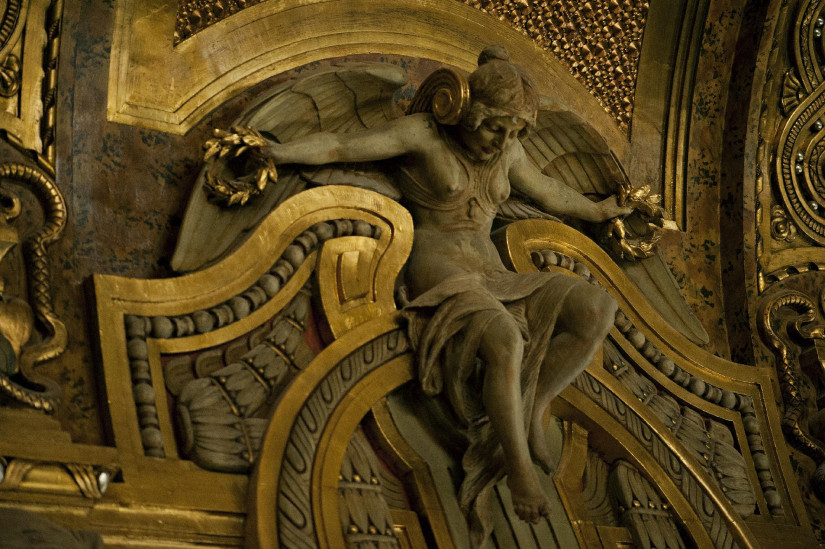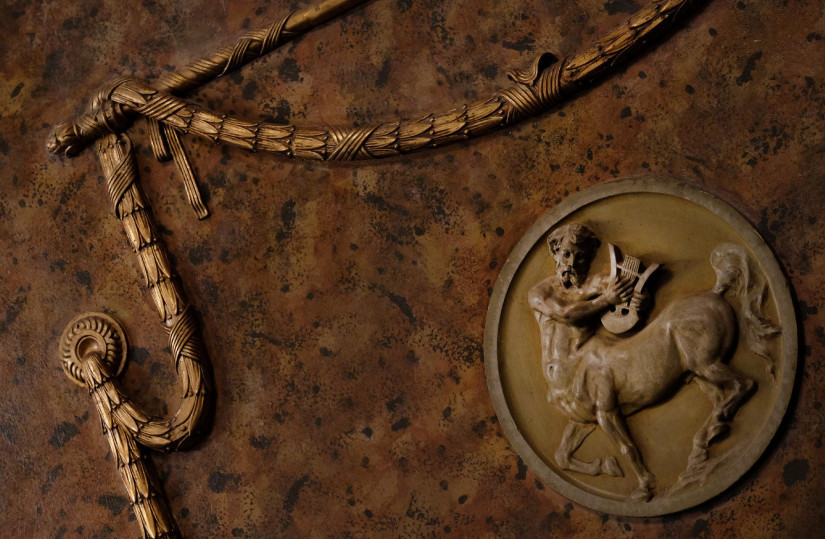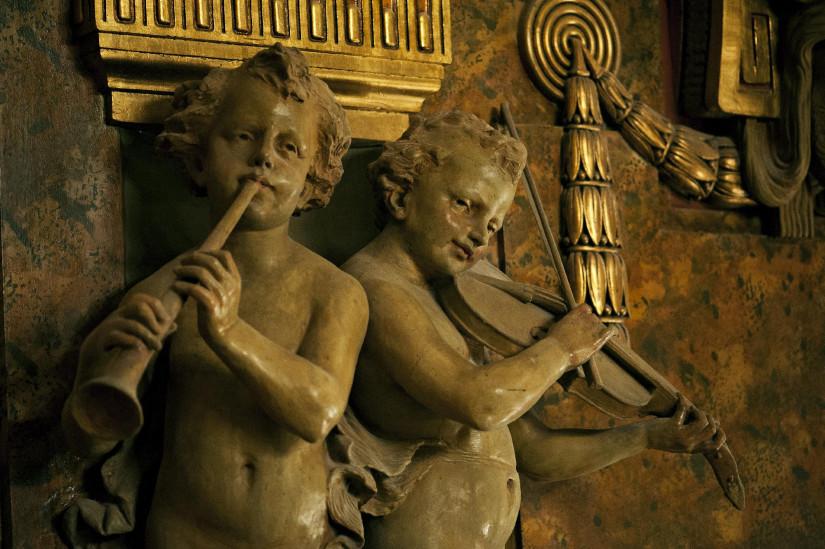Fantasy and fantasia at the Liszt Academy
Six skylights made of stained glass and compressed beads and set in the decorative ceiling of the grand hall of Budapest’s Liszt Academy play a spectacular role: they form the terminal elements of the longitudinal walls, which are divided into three segments by the doors on the ground floor and the windows upstairs.
Predominantly blue, green, yellow and white, the skylights were produced in Miksa Róth’s workshop – renowned for glass mosaics and stained glass that even adorn the Parliament and Buda Castle. The patterns are mainly couplets of arching waves and rosettes that border a different word in each skylight (words which translate to Melody, Rhythm, Harmony, Poetry, Beauty and Imagination).
The blues recall the colour scheme of the Foyer, while the yellow and white tones complement the gilded shimmer of the Grand Hall. The greens now mostly dot the balustrades and the bands bordering the large ceiling coffers after the most recent restoration, which aimed to reconstruct the original colour scheme. The wave pattern dominates the design of the Foyer, while rosettes are perched on the ceiling and on the consoles lining the openings of the balconies along the sides of the Grand Hall.

The composition on the transverse arch in the grand hall is plotted around Apollo’s lyre,
surrounded by the altars of the god with their serpent motif.
An angel holding the god’s laurel wreath descends from above. Photo: Judit Marjai
All of this reminds the viewer that the skylights may be interpreted both in terms of architectural articulation and the iconography of the building, where they most probably also function as terminal elements. These components are overpowered by the brightness above the blue waters, much as the laurel grove dedicated to Apollo overpowers the waters and shores of the foyers. Illuminated in light from the heavens, the words appear beyond the foliage of the laurel plants. Their ethereal/divine origin, just like that of the angels in the hall, is therefore beyond doubt. The words inscribed in the skylights within the temple of Apollo allude to music; however, they carry undeniable relevance to other art forms (as personified by the female figures dancing on the Fountain of the Arts in the foyer upstairs). Indeed, the same holds for Fantasy, which, if we consider a cognate musical term, fantasia, points to a genre of music that pieces together a wealth of alternating patterns much like improvisation. A fantasia (or fantázia in Hungarian) is also known as an 'ábránd' (or daydream) in Hungarian terminology. Nevertheless, the creators of the building’s iconography refrained from using that word. Invoked in the 'painted skies' above the Grand Hall, this could have been seen as a rebuff of the great poet Mihály Vörösmarty, which was certainly not the designers’ intention. Yet, Fantasy appearing in one of the terminal patterns could still be interpreted as an artists’ manifesto against the tastes epitomised by Vörösmarty. One asks therefore to what degree can the sense of this 'manifesto', i.e. the role of fantasy, be captured in the building and in the iconography of the Liszt Academy. To what degree can the building, designed by architects Flóris Korb and Kálmán Giergl, be seen as a work of fantasy?

The centaur playing the lyre depicts wise Chiron, who taught Achilles to sing and play the lyre.
Photo: István Fazekas
One cannot say that it was the fantasy of the building’s designers and its iconographic representation that formed the iconography of the building, which relies on the Apollonian–Dionysian duality in the arts and in the way the arts had changed and had been re-shaped in history.

Detail of the ceiling of the grand hall: head of Apollo and Apollo’s attributes: a pair of swans and lyre.
Photo: István Fazekas
All the more so because the same pattern is recognisable in the iconography of 19th-century opera houses and concert halls (which draw heavily on the Baroque and its traditional preference for 'painted skies'). Strangely enough, the pattern owes its popularity to Nietzsche’s version of this duality, The Birth of Tragedy. However, it was not merely the decorative manifestation of the elements of this duality that set the fantasy of the Liszt Academy’s designers into motion. Their imagination responded instead to the opportunity to use the building as a whole, including details and interrelationships, decorative patterns and architectural solutions, its spaces and its façades, as a vehicle for displaying this duality. Moreover, given all this, it is possible to present this duality hierarchically. Interestingly enough, a factor that normally affects fantasy and artistic freedom adversely also contributed to keeping the imagination of the architects in motion. That factor is political pressure, which in this case meant that the Ministry of Education and Religion in its capacity as client wanted to see a more traditional building with a more historical character: something that was less fantastical than the Hungarian-style Art Nouveau building it had rejected. The dismissal of earlier designs brought with it (another round of) imaginative efforts and also came as a warning that an unrestrained flow of fantasy could trigger a tedious redrawing of plans or even the awarding of the design contract to different architects. Indeed, the client’s explicit and implicit requirements prevented the architects from letting their imagination run wild, a circumstance which might give rise to exaggerations of which most artists are truly apprehensive, at least according to research conducted by Edgar Wind. It is only with the constraints set by those requirements that fantasy could be put into play. Yet, the limitations imposed by the client were not enforced uniformly in respect of the exterior and the interior of the building. This is clearly demonstrated by the fact that only the blueprints for the redesigned façade had been completed by the time the construction plans were approved, while the detailed blueprints for the Grand Hall were drafted only subsequently, when supervision had presumably 'slackened' as the power of control passed from the Minister to the level of the Ministry’s Arts Department.

The pairs of puttos standing on half columns play music and sing on both sides of reliefs depicting musical directions.
Photo: Judit Marjai
While the designers’ fantasy had little room for movement while the plans for the new façade were being created, it had more freedom to soar in respect of interior spaces, especially in the Grand Hall. Unlike the exterior, where references to earlier styles (of architecture) correspond in meaning to the original iconographic representation, the interior gives precedence to architectural solutions that rely on patterns of natural origin and the power of association. Modelling the Grand Hall to resemble a laurel grove and decorating it as a ritual site are therefore products of creative fantasy. Imagination could have been encouraged by the Secession House in Vienna as well as the written and literary documents of the intellectual movement known as Kunstreligion.
From among the key words inscribed in the skylights in the Grand Hall, it was not only Fantasy that promoted the design of the Liszt Academy building or gave shape to and provided historical forms to the creative and scholarly aspirations that determined the iconography. The designers were also guided by the notions of Beauty, Poesy, Harmony, Rhythm and Melody. It is beyond doubt that the melody here evokes the Apollonian–Dionysian duality.
Dr. Endre Raffay


